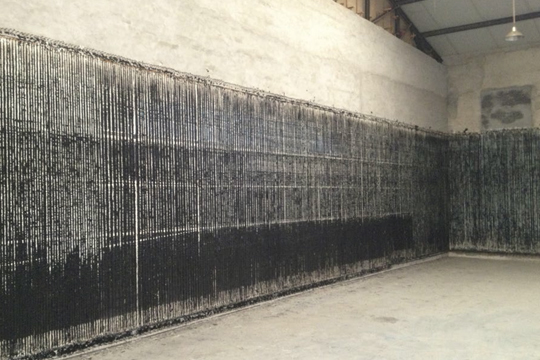TANG SONG: ELEGY—IN MEMORY OF HANS VAN DIJK
| July 24, 2013 | Post In LEAP 21

Courtesy of Boers-Li Gallery
The exhibition opens with two photographs of the artist, Tang Song, being taken away by police, stepping on the logo of “no returns” of the “China Avant-Garde Exhibition” at the National Art Museum in 1989. In a letter Tang Song had written to the late Dutch archivist Hans van Dijk soon after his release from his short imprisonment—he had taken blame for his partner Xiao Lu’s gunshot at their installation, Dialogue—the renegade artist objects to the common claim of the gunshot being a mere piece of destructive performance art, but rather, “A provocation to the media, a disruption of the audience’s visual and auditory experience, a contestation to the law, a rebellious act against art education in China and an impulsive decision propelled by China’s New Wave movement.” Trained in Chinese ink painting at the then Hangzhou Academy of Art, Tang Song’s art practice at present seems to have returned from negotiating with social and political factors to the asceticism of painting. Focusing on his practice and process, Tang mediates between past traditions and contemporary forms, between East and West, or to an extreme, between life and death.
The “Bridge” series, for example, is characterized by thick layers of monochromatic base—one imagines the artist’s repeated laboring to create dimensionality above the surface of the canvas—that are then dented, gridded with vibrant colors of orange and green, or entirely tarred in black. These dents and ruptures disrupt the accumulated base layer and adorn them with emotive establishments. Like the rendition of the piece Bridge, abstract lines in disarray do not identify the object ostensibly portrayed—yet one may associate the work with van Dijk, or perhaps, the artist’s memory of his late mentor. Moreover, these may also suggest momentary outbursts of violence or altercations, metaphors for the tumultuous experiences of coming into contact with novel and foreign ideas that may have impacted the artist. With the audience unable to witness the disruptions, the colors act as a register of both the emotive vehicle and a manifestation of the unseen moment. This genre of painting, known as “action painting,” was first used to describe Jackson Pollock, whose outpour of paint engaged his body in art making. The same idea ties in with van Dijk’s influence on Tang Song; art making should engage physical labor, should produce the real thing rather than its representations.
On the other hand, gridded lines of nondescript geometric forms are a trope for works such as Fig Leaf, Pandora, Archaeology, and 19890631. Collectively, these perplexing lattices present a density that reverberates into a penetrating vortex-esque abyss. The subliminal imagery mesmerizes, beseeching the viewer to inquire how the artist’s uneasy relationship with the past, foreign tradition, knowledge, or even an invented day of his life (June 31, 1989) amidst social turmoil is mediated through his creations.
The centerpiece of the exhibition, the 25-meter-long by 3-meter-wide scroll Elegy—In Memory of Hans van Dijk conjures the qualities of these two aforementioned tropes, while also embodying Tang’s accolade to the late archivist, who was instrumental in establishing a “bridge” for contemporary art between China and the West. For over 25 years, van Dijk frugally and like an ascetic monk “crossed the river by touching the stones”—even without any infrastructure of the art world, he sought and created opportunities to build this bridge. To attribute this solo exhibition to Hans van Dijk, Tang Song perhaps intends to demonstrate solidarity as much as he does respect. Enacting the ascetic monk, Tang maintains that the final image is not envisioned at first, that its complexity and unexpected actions determine its final realization. Like the fabled gunshot, perhaps “Elegy” is meant to be another unexpected action from Tang—and perhaps the final image is of Hans van Dijk, of one man’s legacy as fired by another.

